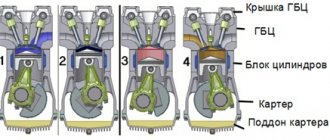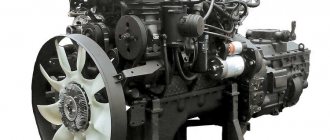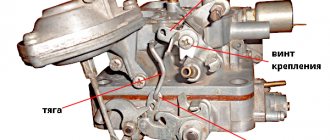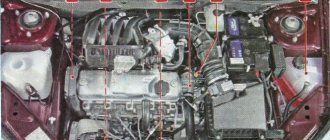A manual gearbox (MT) is designed to convert and transmit torque from the engine to the vehicle's transmission with a stepwise change in gear ratio.
Models of the Volzhsky Automobile Plant were equipped with four and five-speed gearboxes. The VAZ 2107 began to be equipped with a five-speed gearbox in 1982. This box is one of the successful design solutions of “classical” mechanics.
Like all mechanisms that have rotating and rubbing parts, the gearbox is also subject to intense wear. The structure of the unit is complex, so maintenance and repairs are best done in specialized workshops with the assistance of trained personnel.
Although every car enthusiast who knows how to hold a tool in his hands, having studied the device and the procedure for performing work, can carry out maintenance and repairs in his garage.
Five-speed manual transmission
The seventh model Zhiguli has a five-speed gearbox with five forward speeds and one reverse.
It is made of duralumin and has similar covers on the front and back. The clutch cover is attached to the front of the box using studs. A steel cover is installed on the bottom of the device. There are sealing gaskets between the box body and each lid.
The front cover is connected to the clutch housing using a press fit. There is a hole in it for the input shaft to exit and install the cuff.
Inside the box, shafts with gears, synchronizers and gear shifting devices are installed in a certain order. There is an oil filler hole on the right, and a drain hole with a magnetic plug on the bottom.
At the bottom left of the cover comes the speedometer cable, which is driven by the secondary shaft using a gear.
The gear shift lever is on top. Consists of a gear selection device, rods and a locking mechanism. A handle is attached to the lever on top. This entire structure is attached to the lid using three studs.
Type of gearbox:
- Clutch cover.
- Breather.
- Box body.
- Rear cover.
- Gear shift lever.
- Lever housing.
- Coupling flange.
- Screw.
- Speedometer drive.
- Tray cover.
- Hole for filling.
Exploded parts:
- Fork for engaging 3rd and 4th gears.
- Fork for engaging 1st and 2nd gears.
- Fork fastener.
- Engraving washer.
- Fork rod for engaging 1st and 2nd gears.
- Rusk.
- Fork rod for engaging 3rd and 4th gears.
- Gear shift lever.
- Fork rod for engaging 5th gear and reverse.
- Rusk.
- Rusk.
- 5th gear and reverse detent spring.
- Retainer cover with gasket.
- Retainer springs.
- Ball retainers.
- Fork for engaging 5th gear and reverse.
- Sleeve.
Moving parts of the gearbox:
- Intermediate shaft.
- Front intermediate shaft bearing.
- Rear main shaft bearing.
- Input shaft with 4th gear gear.
- Synchronizer clutch for 3rd and 4th gears.
- Synchronizer clutch hub.
- Synchronizer clutch for 1st and 2nd gears.
- Synchronizer clutch hub.
- Front secondary shaft bearing.
- Secondary shaft.
- Intermediate bearing of the secondary shaft.
- Rear secondary shaft bearing.
- 5th gear synchronizer clutch.
- Synchronizer clutch hub.
- Reverse gear.
- Gear with 5th gear synchronizer.
- Speedometer drive gear.
- Gear block for 5th gear and reverse gear.
- Gear block bearing.
- Reverse intermediate gear.
- Reverse idler gear axis.
- Rear intermediate shaft bearing.
- Gear with 1st gear synchronizer.
- Gear with 2nd gear synchronizer.
- Gear with 3rd gear synchronizer.
Shift drive
The five-speed gearbox of the “seven” has a mechanical shift drive. It consists of:
- Speed selection mechanism.
- Shift lever.
- Rods with forks.
- Locking device.
- Retainers.
There is a handle at the top of the lever. The lever rod is attached to the lower part using an elastic damper bushing. The latter partially absorbs vibration and contributes to smoother gear shifting of the VAZ-2107 gearbox (5-speed). The lever design is very simple.
It consists of a spherical part, which is movably fixed in the ball joint housing. The bottom of the lever fits into the grooves of one of the rods. So, turning in the support, the lever acts on the rod and switches the fork into 1-2 and 3-4 gears. As for the fifth speed and rear, a separate rod is provided for them in the hole, which is made in the area of the rear wall of the crankcase. The rod is held in the neutral position by spring-loaded ball retainers.
The latter are located in the bushing of the gearbox housing holes and are closed with a lid. To prevent the simultaneous engagement of several gears, the VAZ-2107 5-speed gearbox has a locking device. It consists of three crackers. The latter are present in the hole in the fourth and third gears, as well as on the rear wall of the transmission housing.
Gear ratios at the gearbox
The seventh model of the Zhiguli received a good version of a five-speed gearbox. The designers of the Volzhsky Automobile Plant took a box from a VAZ 2105 as a prototype, replaced the gear ratio of the main gearbox pair from 4.3 to 4.1, then to 3.9 and obtained the following gear ratios.
| home | 1st gear | 2nd gear | 3rd gear | 4th gear | 5th gear | Reverse |
| 4,1/3,9 | 3,667 | 2,100 | 1,361 | 1,000 | 0,820 | 3,530 |
The gear ratio is the ratio of the number of teeth on the driven gear to the number of teeth on the drive gear.
Primary shaft
The input shaft transmits torque from the engine crankshaft through the clutch disc to the gearbox. The disc is located on the splines of the front part of the shaft. A constant mesh gear is rigidly mounted on the shaft.
For free rotation, it is placed in two bearings. One bearing is located at the end of the crankshaft, the other is in the front cover of the gearbox.
Secondary shaft
In a complex gearbox mechanism, the secondary shaft is the final stage in converting torque and transmitting it to the cardan. The gears of the first three speeds move freely on this shaft. At a certain gear, they engage with the intermediate shaft gears and provide the required torque.
The shaft is placed in bearings, there are three of them. One is pressed into the end of the input shaft, the other into the box body, and the third into the rear cover.
Intermediate shaft
The intermediate shaft transmits rotation from the primary shaft to the secondary shaft.
He plays the role of a satellite. The gears and shaft are made from a single piece. It is installed on three bearings. The gears for fifth and reverse speed are located on it.
Forks
In the process of switching speeds, forks are involved, which move gears along the shaft to a certain place.
The gear shift lever moves the forks.
Characteristic
The main task of any transmission is to perceive and transmit torque from the engine flywheel to the drive wheels. The VAZ-2107 has a conventional six-speed manual transmission.
Among them are five front and one rear. The gear shift pattern is almost the same as on the early four-speed manual transmission. The only difference is that to engage fifth speed you need to move the lever all the way to the left and forward.
Technical characteristics of manual transmission
In the operating instructions, the technical characteristics of the box are indicated together with the characteristics of the transmission. This is given in tabular form:
| Clutch | Single-disk, dry with hydraulic drive and central diaphragm spring |
| Transmission | Mechanical, five-speed, three-way, three-shaft, with synchronizers on all forward gears |
| Gear ratios | |
| First | 3.667 |
| Second | 2.100 |
| Third | 1.361 |
| Fourth | 1.000 |
| Fifth | 0.820 |
| Reverse | 3.530 |
| Cardan transmission | Twin-shaft with intermediate support and elastic coupling |
| main gear | Hypoid |
| Final drive ratio | 3.9 or 4.1 |
| Differential | Conical, two-satellite |
What kind of gearbox can be installed on a VAZ 2107
Initially, the “Seven” was produced with a “four-speed”, so you can install any VAZ gearbox from rear-wheel drive “Zhiguli” on it. You should know what functions the car will perform. If you use it as a workhorse, carry loads, pull a trailer, then a four-speed gearbox will do. It is more durable and resistant to variable loads. If high-speed driving on highways is necessary, then a five-speed gearbox is suitable.
It is possible to install boxes from foreign cars.
The best option is a box from an Italian Fiat model, since this is a prototype of our VAZ.
You can also install it from an early model BMW, but for installation you will have to redo the fastenings.
Transmission malfunctions
The box on the seventh model Zhiguli is considered a reliable unit. If you maintain it regularly and treat it with care during operation, then repairs will not be needed for a long time. However, all components and parts are subject to wear. There are many reasons for this. In any case, if a malfunction is detected in the gearbox, it is necessary to carry out diagnostics and repairs.
Most malfunctions occur of the following types.
One of the gears does not engage
Without opening the box, we can assume that:
- the hinges and springs are worn out and need to be replaced, or better yet, a complete repair;
- on synchronizers, the rings have become unusable and need to be replaced;
- synchronizer spring burst, replace;
- The teeth on the transmission gears are worn, replace the gear.
Knocks out gear when driving
It happens that when you turn on a gear, it does not turn off randomly. Possible reasons:
- the lever hinge is jammed, inspect and clean;
- the clutch is faulty, it may not engage completely, adjust it, if the disc is worn, replace it;
- The shift lever is broken, replace it with a new one;
- Forks, shift gears are bent, replace with new ones.
Crunching and grinding in the box while driving
This problem appears for the following reasons:
- the bearings are worn out, they should be replaced, and at the same time check the seals;
- the teeth of the gears are worn out, in this case it is better to make a major repair;
- There is not enough or no lubricating fluid in the gearbox, find the leak and fix it, add oil.
Grease leaking from box
The gearbox is designed so that lubricant cannot leak out spontaneously. But if an oil stain has formed under the car, an inspection should be made and the leak eliminated.
The reason may be:
- wear of oil seals and sealing gaskets due to natural aging of rubber must be replaced with new ones;
- the fastenings of the covers on the box have become loose, tighten all the nuts and bolts completely;
- mechanical damage to the body or lids of the box; if the steel lid is damaged, it can be welded. If the crankcase is damaged, it is better to replace it, since it is cast from an aluminum alloy.
Signs and causes of box malfunctions
The gearbox on the VAZ 2107 is considered a fairly reliable unit, however, during long-term use, some of its elements may fail for one reason or another. If the first disturbances in the operation of the gearbox appear, in order to avoid more serious breakdowns, it is necessary to diagnose and fix the problem as quickly as possible.
The list of main breakdowns of the VAZ 2107 manual transmission, the causes of their occurrence and methods of elimination are varied. It is important to pay attention to the following signs, as well as choose the right repair methods:
- The gears are engaged randomly or not at all (wear of the moving parts of the gearbox (spring, hinges), wear of the locking rings on the synchronizers, wear of the synchronizer spring, wear of the teeth on the gears). The problem is eliminated by replacing faulty parts, or by carrying out a major overhaul of the box;
- The gear is knocked out when switched on, the engine is subjected to heavy loads (the clutch is not fully engaged, the hinge on the shift lever is jammed, the shift lever is faulty, the forks in the gearbox are deformed).
The problem is eliminated as follows: adjusting the clutch mechanisms, cleaning the hinge joints, replacing the lever or replacing a whole set of forks; The occurrence of uncharacteristic sounds (noise, crunching) while the car is moving (noise of bearings, wear of teeth on gears, lack of lubricating fluid, movement of shafts along their axis). The problem is solved by replacing a deformed or worn part or by identifying a leak and replacing/topping up working fluid; - Leakage of working lubricating fluid (wear of oil seals and gaskets, loosening of crankcase fastenings). The problem is eliminated by changing the rubber products or adding oil to the required level (for the VAZ 2107 gearbox, approximately 1.6 liters of oil are required), if necessary, tighten all the crankcase mounting nuts.
VAZ 2107 box repair
Taking into account all the design and operational features of the VAZ 2107 gearbox, carrying out repair work independently is only possible if you have extensive experience in servicing and repairing such units. If the box on a VAZ 2107 needs repair, the main stages of repair work are:
- preparation (availability of the necessary tools, pit or overpass);
- installing the car on a pit/overpass, draining the oil from the gearbox, etc.);
- dismantling the box;
- disassembly and troubleshooting;
- trouble-shooting;
- assembly and installation of the box in place.
Required tools:
- socket wrench at “10” and “19”;
- Phillips-blade screwdriver;
- tweezers and two screwdrivers with a thin flat blade;
The general procedure is as follows:
- install the car on a viewing hole or on an overpass;
- by disconnecting the wire from the negative terminal on the battery, drain the gearbox lubricating fluid (gear oil);
- Having removed the radio panel and pressing the lever, insert a flat-head screwdriver into the hole in the locking sleeve of the box to bring it out;
- Having removed the rod from the lever, use tweezers to remove the elastic rubber insert of the damper from the lever;
We also recommend reading the article on how to replace transmission cables. From this article you will learn when and how to change manual transmission cables in a cable gearbox, as well as what subtleties and nuances you should pay attention to as part of this procedure. - Unclamping the damper petals using two flat-head screwdrivers, remove them from the lever, and then remove the damper lever itself and, accordingly, all its bushings;
- Having moved the upholstery mat on the floor of the car, use a Phillips screwdriver to remove the four screws on the gearbox cover;
- Having removed the gearbox cover and the exhaust pipe of the muffler from the lever, use a Phillips screwdriver to disconnect the block with the clutch;
- Having removed the cable harness and the cardan transmission from the speed device, disconnect the flexible shaft;
- Using a socket wrench set to “10”, unscrewing the two fastening bolts of the side cover of the gearbox, install the support under the box;
- Using a socket wrench set to “19”, unscrew the four fastening bolts connecting the crankcase to the engine block;
- by inserting a flat-head screwdriver into the gap between the block and the crankcase, simultaneously pressing them out, complete the dismantling of the gearbox;
- disassemble the box, troubleshoot, replace parts, etc.
- Having completed the necessary repair work, assemble the unit, install the box on the car, reassembling in the reverse order.
Gearbox seals and their replacement
Oil seals in any mechanism where they exist act as gaskets. In this case, they are designed to seal the holes from which the primary and secondary shafts come out. Previously, oil seals were cast from rubber.
Currently made from modern composite materials, more resistant to temperature changes and aggressive environments.
Input shaft oil seal
The oil seal, which is installed on the input shaft, has the following dimensions:
- • outer diameter – 47 mm;
- • internal diameter – 28 mm;
- • width – 8 mm;
- • weight – 20 grams.
It is installed in the shaft output hole in the clutch housing and serves to prevent lubricant from flowing through the shaft.
There is no difficulty in replacing the oil seal, but the gearbox will have to be removed.
The order of work to change the oil seal is as follows:
- Remove the clutch cover from the gearbox.
- Remove the release bearing and clutch fork.
- Remove the used oil seal by picking it up with a screwdriver or knife.
- Clean the place where the oil seal was located and wipe it dry.
- Install the new oil seal in its original place.
- Replace all the parts that were removed from the box in reverse order.
Secondary shaft oil seal
The oil seal, which is installed on the secondary shaft, is larger and has dimensions:
- outer diameter – 56 mm;
- internal diameter – 32 mm;
- width – 10 mm;
- weight – 10 grams.
It is installed at the output of the secondary shaft at the rear of the box.
The order of work to change the oil seal is as follows.
- Unscrew the nut securing the flange, having previously secured it.
- Remove the centering metal ring from the shaft.
- Remove the flange and washer using a puller.
- Pull out the old oil seal using a tool.
- Clean and wash the seal area.
- Install a new oil seal.
Replacing gears and synchronizers
The work of replacing gears and synchronizers is one of the most difficult when repairing a gearbox. There is a standard repair kit containing all the necessary parts to help cope with the task. It is advisable to prepare a special tool.
Gears and synchronizers on the primary and secondary shafts are changed in almost the same way.
The process goes like this:
- remove the shaft from the box;
- clamp the shaft in a vice, wrapping it in something soft;
- Remove the retaining ring from the shaft using a special tool or a screwdriver:
- press the bearings off the shaft;
- remove the shaft from the vice, place it vertically, resting the first gear on two supports;
- carefully press the gear off the shaft;
- Carry out similar operations with the remaining gears and synchronizers.
Removing and replacing the fifth gear gear occurs differently.
The video clearly shows and explains how to do this:
Transmission repair: when to do it
Repair of the VAZ 2107 gearbox may be required in the following cases:
- Excessive noise is produced when the box operates. This noise is caused by increased wear of bearings, gears and synchronizers.
- It becomes difficult to change the transmission. The reasons for this consequence are hidden in the wear of the lever, the lack of lubricant inside the box, and the deformation of the gearbox lever. Also, the cause of this phenomenon may be jamming of the blocking cracks or damage to the coupling splines.
- Spontaneous transmission shutdown. The reasons for this consequence are wear of the ball holes on the rods, jamming of the clamps, blocking rings and the synchronizer itself.
- Oil leakage occurs. Repair of the VAZ 2107 gearbox must be carried out when oil leaks are detected on it. The causes of leakage can be either serious damage or simple wear of oil seals and seals.
In any case, disassembling the gearbox will be required if one of the above symptoms occurs, which will allow us to identify the exact cause of the malfunction and eliminate it. If even the slightest malfunction of the gearbox is detected, it is necessary to begin repairing it, which will prevent unforeseen consequences in the form of complete failure of the gearbox.
Transmission oil for gearboxes
To select gear oil for the Lada gearbox, you need to take into account the region where the car will be operated.
Two types of oils are offered. The first - with a temperature range from +35 to -26, this is SAE 80W85 and the second - with a temperature range from +45 to -40, this is SAE 75W90.
The best oil is synthetic, but semi-synthetic and mineral oils will not harm the Seven’s transmission. The amount of oil in the VAZ 2107 gearbox is about 1.6 liters. The oil change time is carried out according to the instructions in the technical instructions supplied with the car.
Manual transmission oil level
The oil level in the box is checked as follows:
- drive the car onto an overpass or pit;
- clean the filler plug;
- unscrew the plug;
- measure through the hole with a probe or other object resembling a probe. The oil should be level with the end of the filler hole; top up if necessary.
Oil change
It is better to change the oil on an overpass or pit with a warm engine, so the oil will drain faster. Prepare the tool in advance, a container for working out at least two liters, oil for changing.
The order is as follows:
- clean the fill and drain plugs from dirt;
- Place the prepared container for used oil under the drain hole;
- open the drain hole and wait until the oil completely drains into the container;
- clean the plug of old oil and close the drain hole;
- pour 1.5 liters of new oil into the box through the filler hole (it’s better to fill it with a supercharger);
- let it sit for ten minutes, then check the level and top up if necessary.
Primary shaft
It is made in the form of a constant mesh helical gear. The spur ring of the fourth gear synchronizer is pressed onto the rear belt of the input shaft. On the fourth speed ring there is a locking spring-loaded ring, which is secured with a stopper. The teeth of the inner ring mesh with the fourth gear synchronizers. There are splines on the front of the shaft where the clutch driven disc is secured.
How does the shaft rotate? For this purpose, the VAZ-2107 gearbox (5-speed) has two bearings. One is installed in the front wall of the transmission housing, and the second is installed at the end of the crankshaft. To prevent axial displacement of the shaft, the design has an adjusting ring.










